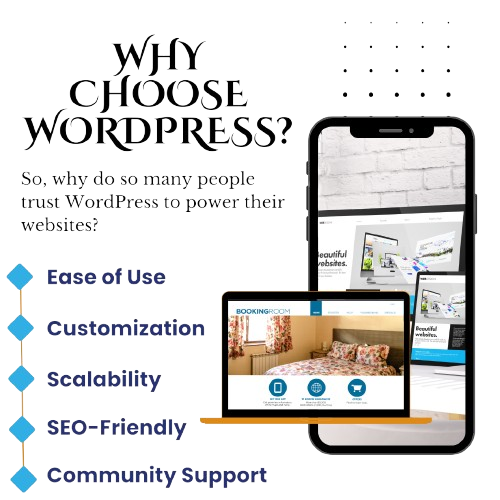Introduction toWordPress Websites
designed to be SEO-friendly, informative, and beginner-friendly.
In the digital age, having a website is no longer a luxury—it’s a necessity. Whether you’re a blogger, business owner, creative professional, or nonprofit organization, your online presence matters. Among the many platforms available for building websites, WordPress stands out as the world’s most popular and versatile content management system (CMS).
This guide will give you a comprehensive overview of what WordPress is, why it’s so widely used, and how you can leverage it to build anything from a blog to a business empire.
🧩 Chapter 1: What is WordPress?
WordPress is an open-source CMS that enables users to create, manage, and customize websites with ease—no coding required. Launched in 2003 as a blogging platform, it has evolved into a full-fledged website builder supporting millions of sites globally.
Key Facts:
Over 43% of all websites on the internet use WordPress.
It’s free to install, use, and modify.
WordPress.org (self-hosted) and WordPress.com (hosted) offer two versions to suit different needs.

🧱 Chapter 2: Why Choose WordPress?
So, why do so many people trust WordPress to power their websites?
✅ Key Benefits:
- Ease of Use: The dashboard is intuitive and beginner-friendly.
- Customization: Thousands of themes and plugins let you design your site your way.
- Scalability: Start small and scale up—WordPress supports simple blogs to large eCommerce stores.
- SEO-Friendly: Built with clean code and supports SEO plugins like Yoast or Rank Math.
- Community Support: A huge global community offers forums, tutorials, and plugins.
🎨 Chapter 3: Themes and Design
Themes control the appearance of your site. Whether you want a minimalist blog or a vibrant portfolio, there’s a theme for that.
Types of Themes:
Free Themes: Available in the WordPress repository.
Premium Themes: Paid themes from marketplaces like ThemeForest or Elegant Themes.
Custom Themes: Built from scratch or customized by a developer.
Pro Tip:
Choose a responsive theme to ensure your site looks great on all devices.
🧩 Chapter 4: Power of Plugins
Plugins add functionality to your WordPress site without writing a single line of code.
Must-Have Plugins:
Yoast SEO or Rank Math: For search engine optimization.
Elementor: A drag-and-drop page builder.
WooCommerce: To build an eCommerce store.
WPForms: Easy form creation.
Wordfence Security: For malware scanning and firewall.
There are over 60,000 plugins available in the WordPress plugin repository!
🖼️ Chapter 5: Content Creation — Pages & Posts
WordPress distinguishes between two core content types:
📄 Pages:
Static content like “About Us”, “Contact”, or “Services”.
Organized and hierarchical.
📝 Posts:
Dynamic content like blog entries.
Can be categorized and tagged.
Both are managed via the WordPress editor and can include text, images, videos, and other media.
📸 Chapter 6: Managing Media
Uploading and managing media is simple with WordPress’s built-in Media Library.
Supported File Types:
Images (JPG, PNG, GIF)
Videos (MP4, MOV)
Audio (MP3, WAV)
Documents (PDF, DOCX)
You can drag and drop files directly into your post or page, and even edit them inside the media manager.
💼 Chapter 7: Types of Websites You Can Create with WordPress
WordPress isn’t just for blogging. It can be used to build nearly any kind of website.
Examples:
Blogs: For personal or professional use.
Business Sites: Showcase your services, testimonials, and contact info.
eCommerce Stores: Sell products or services with WooCommerce.
Portfolios: For designers, writers, and creatives.
Nonprofits: Collect donations and engage supporters.
Membership Sites: Offer gated content or courses.
🔐 Chapter 8: WordPress Security
Security is crucial, especially for eCommerce and high-traffic websites.
Tips to Stay Safe:
Use strong usernames and passwords.
Keep WordPress, themes, and plugins updated.
Install security plugins like Wordfence or Sucuri.
Backup your website regularly (e.g., UpdraftPlus).
WordPress is secure by default, but you must take proper precautions to keep threats away.
Most Frequently Asked Questions(FAQ'S)
WordPress.com is hosted and limited in customization.
WordPress.org is self-hosted and fully customizable.
Absolutely. With a minimal learning curve, even non-tech users can create professional websites.
Yes — through affiliate marketing, ads, selling services/products, or offering paid content.
Yes. Most themes are responsive, and you can preview/edit your site for mobile.
Definitely. Tools like All-in-One WP Migration make this simple.
🧾 Final Thoughts
WordPress is more than just a website builder—it’s a dynamic platform empowering creators, entrepreneurs, and businesses to share their vision with the world. Whether you want to blog, sell, showcase, or grow—WordPress is your canvas.
With the right theme, powerful plugins, and a touch of creativity, you can build an online presence that’s both beautiful and impactful.
